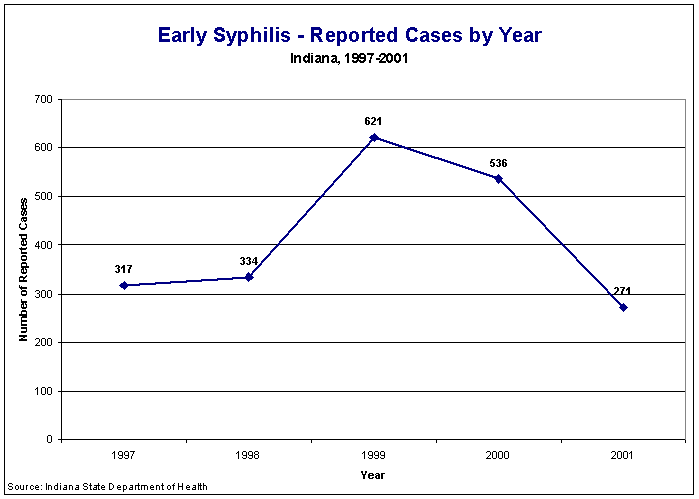Figure Syp1: Early Syphilis - Reported Cases by Year, Indiana, 1997-2001

2001 Indiana Report of Infectious Diseases |
View ISDH's basic facts on sexually transmitted diseases (STD)
View CDC's Syphilis fact sheet page
Rates presented are per 100,000 population and are based on the U.S. 2000 Census.
| Cases | Incidence Rate |
|
| Total | 271 | 4.5 |
| Race-specific cases and rates1 | ||
| White | 46 | 0.9 |
| Black | 207 | 40.6 |
| Other2 | 13 | 5.2* |
| Sex-specific cases and rates | ||
| Female | 136 | 4.4 |
| Male | 135 | 4.5 |
Early syphilis includes primary and secondary syphilis, and early latent syphilis, as defined by the U.S. Centers for Disease Control and Prevention (CDC). These definitions can be found in Case Definitions for Infectious Conditions Under Public Health Surveillance, Morbidity and Mortality Weekly Report, Vol. 46, No. RR-10, May 2, 1997. This can be found online at: http://www.cdc.gov/mmwr/preview/mmwrhtml/00047449.htm.
Elimination of syphilis is an explicit CDC objective. Historically low incidence coupled with the etiologic agent�s role in facilitating human immunodeficiency virus (HIV) transmission and compromising women�s ability to deliver healthy children prompted the CDC to plan and implement the elimination campaign.
In 2001, the ISDH received 271 reports of early syphilis. These persons were infected with Treponema pallidum, the causative agent of syphilis, and diagnostically staged as primary, secondary, or early latent syphilis cases. This number of cases translates to a statewide incidence rate of 4.5 cases per 100,000 residents.
Due to a 1999 syphilis outbreak in Marion County, early syphilis incidence peaked at that time. In 2000, a collaborative campaign to eliminate syphilis between local, state, and federal public health agencies in Marion County began. The outcome of that effort was evident in the reduction of subsequent incident cases (Figure Syp1). The number of reported cases decreased by 13.7% between 1999 and 2000 and by 49.4% between 2000 and 2001. This trend demonstrates significant progress toward syphilis elimination in Marion County.
There is no difference between the sex-specific incidence rates of early syphilis between males and females. There is, however, a significant racial disparity between whites and other races. The race-specific rate for blacks (40.6) was higher than that for whites (0.9) or for other races (5.2). Blacks contributed disproportionately to 2001�s early syphilis morbidity; 76.4% (207 cases) of Indiana's early syphilis infections were among this racial group. By contrast, 17.0% (46 cases) were known to be white. By racial/ethnic grouping and with respect to group contributions to Indiana's total population, blacks were overrepresented, and those classified as white were underrepresented in terms of syphilis morbidity experience.
Most early syphilis cases were reported
among adolescents and young adults, with a somewhat older population affected
relative to the age distribution of reported cases among other sexually
transmitted diseases under surveillance. The
greatest number of cases and the highest age-specific rates were among those ages
20-39 (Figure Syp2);
67.9% (184 cases) of the reported cases were in this age group.
With 210 cases (77.5%) of early syphilis reported, Marion County contributed more than twice as many cases to 2001�s statewide early syphilis burden than all other counties combined (Table Syp1).
Looking ahead to further progress toward elimination of this pathogen from Indiana, the counties with the historically highest morbidity will be those with the greatest potential for resurgence. The presence of even one early case, other than one occurring within 90 days of an imported case, is evidence of sustained transmission.
Back to Top of Article
Back to Table of Contents
|
Figure Syp1: Early Syphilis - Reported Cases by Year, Indiana, 1997-2001 |
|
|
Back to Reference in Text
Back to Top of Article
|
Figure Syp2: Early Syphilis - Incidence Rates by Age Group, Indiana, 2001 |
|
|
Back to Reference in Text
Back to Top of Article
|
Table Syp1: Early Syphilis - Reported Cases by County, Indiana, 2001 |
||||||||||||||||||
|
||||||||||||||||||
Back to Reference in Text
Back to Top of Article
1 - Race was unknown for 5 of the reported cases.
2 - "Other" includes American Indian/Alaska Native, Asian, Native Hawaiian/Pacific Islander, and multiracial.
* - Rate based on less than 20 cases and should be considered unstable.
Back to Table of Contents
[an error occurred while processing this directive]